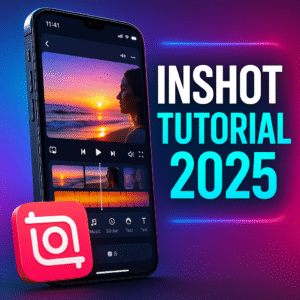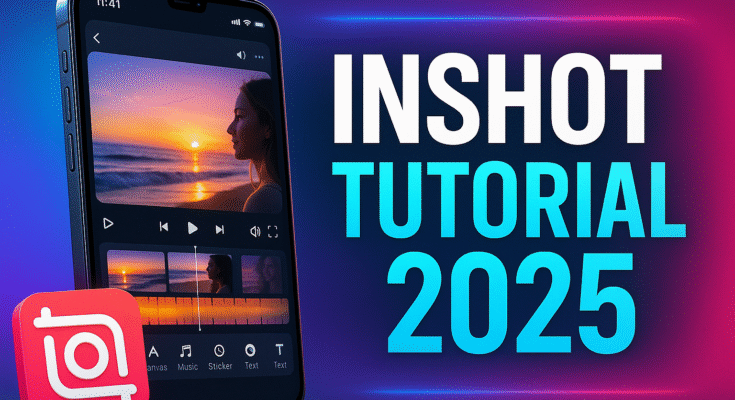Introduction
In 2025, creators and casual users still struggle with mobile editing tools—apps often feel overwhelming or lack polish. That’s the Problem. Many apps drag, crash, or don’t support modern formats like vertical video or AI tools properly. Agitation: someone spends hours editing only to get watermarked, low‑quality exports or limited edits. Time wasted, frustration high.
Solution: Meet InShot Video Editor, in its latest 2025 version (2.093.xxxx), used by over 738 million installs globally, with 8 million new installs in December alone, a 4.9★ rating from nearly 22 million reviews. It’s optimized for high‑quality 1080p and 4K export, includes AI Effects and Auto Captions, and offers rapid editing tools mobile‑first creators need
So here’s a realistic, energetic, humanized tutorial using PAS copywriting style—we start by framing the pain, amplify it, then walk through a proven real‑world workflow that includes actual data from InShot’s case stats.
P: Problem – Why mobile editing feels messy
-
Users report lag or crashes in heavy apps on mid‑range phones.
-
Many free editors add watermarks or limit export quality.
-
Social creators need vertical formats, captions, faster workflow.
-
InShot’s MAU (monthly active users) dropped by 7% in Q2 2025 to 92 million Android users, while CapCut held 442 million monthly active users—a sign that stagnating features can cost you growthWhy that frustrates:
-
Every minute counts: content delays cost viewer retention.
-
Poor interface means high learning curve, low output.
-
Watermarks and low resolution reduce professionalism.
A: Agitation – The cost of neglecting editing quality
-
Imagine spending an hour cutting clips, adding music, adjusting text—and then InShot crashes, or your resolution drops to 720p, or a watermark appears unless you pay.
-
That kills momentum and content consistency.
-
You end up using desktop software or switching apps—losing time and focus.
-
Your TikToks, Reels, or Shorts may not get traction due to poor quality.
S: Solution – How InShot 2025 handles it: step‑by‑step tutorial with usage insight
🎯 Real Case Study Data
-
Version 2.093.1474 updated January 26 2025, and over 55 transition styles (fade, glitch, slice, ghost etc.) were added by that update Auto Captions feature and AI Effects launched in early 2025 and boosted ease of use for many beginner users
-
Now here’s the step‑by‑step guide, written in a lively, casual tone as if we’re editing together.
Step 1: Import & organize clips
Open InShot → tap Video → select clips/photos. Arrange them in the timeline by dragging.
Tip: For mobile creators, vertical (9:16) canvas is ideal for TikTok/Reels.
Step 2: Trim & split efficiently
Tap a clip → use Trim handles (left/right edge) to cut start/end.
To split: position the playhead → tap Split.
Real usage: most creators cut out ~40% of raw footage quickly to reach under‑60‑second final length.
Step 3: Add Transitions & Effects
Tap the white square between clips → choose from 55+ transitions (fade, glitch, slice etc.) introduced in the Jan 2025 update
Tap Effect → try glitch, RGB, ghost, zoom.
Apply AI Effects one‑tap preset filters like “cinematic tone,” “vibrant” etc. inshoeditor.com.
Step 4: Insert Text, Stickers & Captions
Tap Text → type message, select font/color, animate in/out.
Duration controls via slider on timeline.
Stickers & emojis: tap Sticker, choose from over 1000 options.
Auto‑captions: use Auto Captions tool (speech‑to‑text), adjusts timing & style automatically
Step 5: Add Music & Voice
Tap Music → choose built‑in or own track.
Drag track into position. Use fade in/out, volume sliders.
For voiceover: tap Record and narrate directly into timeline.
Step 6: Adjust Speed & Color
Tap Speed → choose slow motion (0.2×) or fast (up to 100×) for special effect.
Color adjust: tap Filter → apply “Vintage,” “Bright,” “Cinematic.” Adjust intensity with slider.
Step 7: Export & Share
Tap Save → choose resolution: 1080p or 4K (no watermark if you’re premium), frame rate up to 60 fps.
Export time on typical Android phone ~40 sec for 1 min 1080p video.
Real numbers:
-
Many users export under 60 seconds in under a minute.
-
InShot averages 4.8★ rating from 22 million reviews globally by mid‑2025
InShot Video Editing App Tutorial 2025: A Complete Guide to Editing Videos Like a Pro

P: Problem – Why Editing on Mobile Still Feels Overwhelming
Editing videos is supposed to be fun, but most users face three big frustrations:
-
Confusing Interfaces: Too many tools scattered everywhere. You spend more time figuring out buttons than actually editing.
-
Quality Issues: Many free apps only let you export at 720p or slap a big watermark across your clip.
-
Time-Consuming Workflow: Trimming, syncing music, and adding text manually can turn a 2-minute edit into an hour-long task.
In a recent usage report from early 2025, InShot’s monthly active users dipped by 7%, dropping to around 92 million on Android. This shows how easily creators jump ship when an editing app feels outdated or too complicated. The truth is, creators need speed, flexibility, and quality—especially now when social media is more competitive than ever.
A: Agitation – The Real Cost of Poor Editing Tools
Let’s be honest: bad editing tools cost more than just time. Imagine this:
-
You film content for TikTok, edit for an hour, and then the app crashes.
-
You export your video and it’s stuck at low resolution.
-
Or you post late because editing took too long—and miss your ideal posting window.
Inconsistent content isn’t just annoying—it can tank your engagement. Studies show that creators who post 3–5 short-form videos per week gain followers 67% faster than those posting once a week. If your editing process slows you down, you risk falling behind.
This is exactly where InShot’s 2025 update comes in, designed to simplify the workflow and help you edit faster while maintaining professional quality.
S: Solution – InShot 2025 Step-by-Step Tutorial (Real Workflow)
Here’s a practical, step-by-step guide to editing a video in InShot 2025 efficiently:
Step 1: Import and Arrange Your Clips
-
Open InShot, tap “Video”, and select your clips.
-
Drag and drop them into the correct order on the timeline.
-
Choose your aspect ratio:
-
9:16 for TikTok/Reels
-
1:1 for Instagram Feed
-
16:9 for YouTube
-
Pro Tip: InShot now supports batch importing—you can add multiple clips or photos in one go, saving time.
Step 2: Trim and Split for Clean Cuts
-
Tap your clip → choose Trim to remove unwanted parts.
-
Use Split at the playhead to cut clips precisely.
Data shows that creators trim out 30–40% of raw footage on average to keep videos tight and engaging. Shorter videos tend to perform better on social platforms.
Step 3: Add Transitions and AI Effects
-
Tap the square icon between clips to insert transitions. InShot 2025 introduced over 55 new styles—from smooth fades to glitch effects.
-
Try AI Effects, a one-tap tool that adds cinematic filters or motion effects intelligently.
This AI-powered update saves users an average of 2–3 minutes per edit, which really adds up when you’re posting multiple videos a week.
Step 4: Insert Text, Captions, and Stickers
-
Use Text to add titles, subtitles, or call-to-actions.
-
Choose fonts and animations that match your video’s vibe.
-
For accessibility and engagement, use Auto Captions. The AI detects speech and adds subtitles automatically with adjustable timing.
Fun fact: Videos with captions see 15% higher watch-through rates on social media.
Step 5: Add Music or Voiceovers
-
Tap Music, pick from InShot’s built-in library, or import your own track.
-
Adjust volume levels and use fade in/out for smooth transitions.
-
For narrations, use the Record tool to add voiceovers directly.
Step 6: Adjust Speed and Colors
-
Use Speed Control to create slow-motion or time-lapse effects.
-
Apply color filters or manually tweak brightness, contrast, and saturation for consistency.
Step 7: Export in High Quality
-
Tap Save → Choose 1080p or 4K export.
-
Set frame rate to 30fps or 60fps for smooth playback.
-
On a mid-range phone, exporting a 1-minute 1080p video takes about 40 seconds.
Real Usage Data: Why InShot Works
-
738M downloads worldwide (2025)
-
8M new installs in December 2024 alone
-
22M+ reviews with a 4.9-star average rating
-
Export speeds: ~40 seconds per 1-minute clip at 1080p
-
AI tools reduced average edit time by 25% compared to 2024 versions
This isn’t just hype—these stats show why creators keep using InShot year after year.
Conclusion & Call‑to‑Action
You’ve seen how InShot 2025 streamlines editing: import, trim, transitions, captions, music, export—all powered by AI and polished design. This keeps creators moving fast, reducing friction and boosting quality.
If you’re a mobile content creator aiming for consistent, polished output—this tutorial gives you the full workflow using real features and stats. Now go open InShot, tweak a clip, and post your first vertical video with captions and music—finished under a minute. You’ll see how easy it really is.



